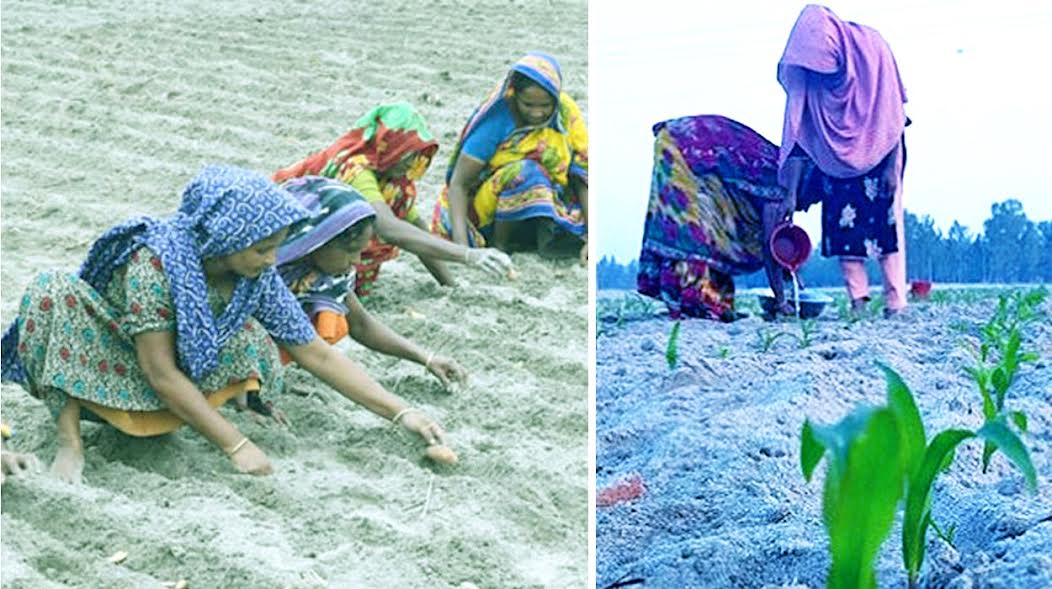News Flash

By Md Mamun Islam
RANGPUR, Oct 17, 2025 (BSS) - Like previous years, this year too, riverine people have started cultivating various winter crops in the mixed-relay system in the char areas of the Brahmaputra basin in the Rangpur agricultural region.
Officials of the Department of Agricultural Extension (DAE) said, soon after recession of floodwater, char people started sowing crop seed on char lands and dried-up riverbeds following the appearance of shoals with deposition of highly fertile alluvial soils.
Rangpur regional Acting Additional Director of the DAE Krishibid Md Sirajul Islam said people are cultivating various crops on around 82,000 hectares of char lands in Rangpur, Kurigram, Gaibandha, Lalmonirhat and Nilphamari districts of the region every year.
Hundreds of riverside and char people and farmers are producing about six-lakh tonnes of various crops worth Taka 1,200 crore from 82,000 hectares of char lands and dried-up riverbeds in Rangpur agricultural region annually.
"Bumper production of varieties of crops in char lands during the winter season keeps the char economy vibrant bringing fortune to many people living there," Krishibid Sirajul Islam told BSS.
Along with increasing food production by cultivating various crops on sandy char lands, char people are reaping rewarding profits from harvesting various crops every year to lead a better life.
People are mostly cultivating potato, sweet pumpkin, sesame, linseed, squash, brinjal, onion, carrot, garlic, green chili, gourd, bitter gourd, banana, mustard, pulses, cauliflower, cabbage, mustard, sunflower, groundnut and wheat, maize, indigenous varieties of Boro rice and vegetables on char lands.
The vast marshes, bottomlands and alluvial plains of the Brahmaputra, Teesta, Dharla, Dudhkumar, Ghaghot, Yamuna, Kartoa and other rivers will soon turn a striking green with the progress of winter crop cultivation.
"They will begin harvesting their cultivated crops from late December to end the process before the commencement of the rainy season," Krishibid Sirajul Islam said.
Deputy Director of the DAE's Burirhat Horticulture Centre in Rangpur city Krishibid Dr Md Abu Sayem told BSS that people of char and riverine areas have put their maximum efforts in cultivating crops on their flood-hit char lands.
Farming of winter crops is expanding every year on char lands in Rangpur agriculture region, mostly adopting intercropping and mixed-relay methods, benefiting hundreds of char people and bringing about a revolutionary change in the char agro-economy.
"Getting assistance from the government, many char families have already achieved self-reliance through farming various crops on char lands changing their living standard and livelihoods in recent years," Sayem said.
Soon after the recent flash flood, char people of villages Gannarpar, Buridangi, Singhimari, Miazipara, Motukpur, Kolkond, Bagdohra and Chhalapak of Gangachara upazila in Rangpur are becoming busy in cultivating crops on char lands.
Talking to BSS, riverside and char people Mahbubul Islam, Mahbub Hossain and Anwar Hossain of village Paschim Mohipur in Gangachara upazila of Rangpur said they are preparing to sow seeds of winter crops now on char lands like previous years.
Nur Hossain of village Purbo Mohipur in the upazila cultivated maize, potato, garlic and onion on 1.50 acres of char lands on the dried-up Teesta riverbeds and got bumper yield last season.
He is preparing to cultivate the same crop on the char land this year as well.
Mahabbat Hossain, Abdul Malek and Abed Ali of Dhushmara Char in Kawnia upazila of Rangpur said they are preparing to sow pumpkin seeds and potatoes on char lands now after earning lucrative profits by selling their produce last year.
Jahanara Begum, Aklima Khatun and Akbar Hossain of village Char Montola and Afsar Ali of Char Goynar Patal in Chilmari upazila of Kurigram said they are sowing seeds of various winter crops like 'Khira', green chilli, maize and other crops on char lands.